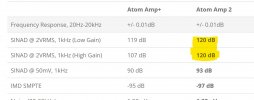I love the look of this headphone amp and it measures great whilst being made in the USA which is really quite a feat for the low price! I have just one concern with the measurements and that's the channel balance - Amir said it was perfect for channel balance but there's a significant blip in the channel balance of over 2.5dB difference between channels which occurs between 12-13sec on this graph:

So surely that's not great channel balance performance and particularly not if you were to use it between the 12-13sec point which equates to the -40 to -75dB position on the volume knob. Am I missing something here?
I mean for comparison the original JDS Labs Atom Amp from year 2018 had better channel balance:

So surely that's not great channel balance performance and particularly not if you were to use it between the 12-13sec point which equates to the -40 to -75dB position on the volume knob. Am I missing something here?
I mean for comparison the original JDS Labs Atom Amp from year 2018 had better channel balance:

